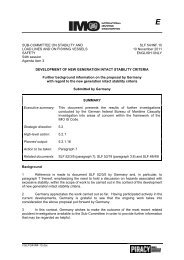Examination of the intact stability and the seakeeping behaviour
Examination of the intact stability and the seakeeping behaviour
Examination of the intact stability and the seakeeping behaviour
You also want an ePaper? Increase the reach of your titles
YUMPU automatically turns print PDFs into web optimized ePapers that Google loves.
7 Conclusions<br />
Summing up <strong>the</strong> results from <strong>the</strong> <strong>the</strong>sis can be done by stating: All examined container vessels<br />
have a signicant problem with <strong>the</strong>ir <strong>seakeeping</strong> behavior in <strong>the</strong> ballast arrival loading condition.<br />
Within this examination, all vessels reach very high transversal accelerations on <strong>the</strong>ir bridges.<br />
This problem with excessive accelerations occurs for loading conditions, where <strong>the</strong> vessels have<br />
no or only few cargo on board resulting in ra<strong>the</strong>r small drafts <strong>and</strong> thus high <strong>stability</strong> values. For<br />
twelve <strong>of</strong> <strong>the</strong> analysed vessels <strong>the</strong> ballast arrival loading condition is most critical while for <strong>the</strong><br />
three largest vessels <strong>the</strong> most critical condition occurs at higher drafts at <strong>the</strong> FP.<br />
Fur<strong>the</strong>r, this <strong>the</strong>sis proves that <strong>the</strong> named problem is not caused by <strong>the</strong> high <strong>stability</strong> values<br />
only. O<strong>the</strong>r factors like <strong>the</strong> ship's trim or <strong>the</strong> ship's hull form also have a great inuence on <strong>the</strong><br />
<strong>seakeeping</strong> behavior. Therefore a simple approach like <strong>the</strong> determination <strong>of</strong> a single upper limit<br />
for <strong>the</strong> GM does not seem to be a feasible approach to avoid such accidents in <strong>the</strong> future.<br />
Particularly due to distinctive nonlinear eects, mainly on <strong>the</strong> roll motion, <strong>the</strong> <strong>seakeeping</strong><br />
behavior can denitely not be calculated with simple linear approaches. Therefore it is recommended,<br />
that <strong>the</strong> <strong>seakeeping</strong> behavior for each single loading condition should be evaluated<br />
during <strong>the</strong> early design process by <strong>the</strong> application <strong>of</strong> numerical methods, which are capable to<br />
simulate <strong>the</strong>se nonlinearities. In this way it can be identied, whe<strong>the</strong>r a ship's ballast arrival<br />
loading condition should be stated to be a seagoing condition or if <strong>the</strong>re is an increased risk<br />
<strong>of</strong> accident. With such methods, it is possible to reproduce <strong>the</strong> behavior <strong>of</strong> <strong>the</strong> ships during<br />
real accidents very well (refer to <strong>the</strong> accident reports [1][2][3]). Thus <strong>the</strong> <strong>seakeeping</strong> calculations<br />
performed for this <strong>the</strong>sis, also represent well <strong>the</strong> real <strong>seakeeping</strong> behavior <strong>of</strong> <strong>the</strong> analysed vessels<br />
<strong>and</strong> are adequate to estimate <strong>the</strong> risk <strong>of</strong> encountering an accident.<br />
Having gained this knowledge, it becomes obvious that <strong>the</strong>re is a need for establishing m<strong>and</strong>atory<br />
regulations for <strong>the</strong> determination <strong>of</strong> <strong>the</strong> <strong>seakeeping</strong> behavior <strong>and</strong> to increase <strong>the</strong> safety on<br />
<strong>the</strong> bridges for <strong>the</strong> crew.<br />
Fur<strong>the</strong>rmore, since <strong>the</strong> excessive <strong>stability</strong> alone is not responsible for <strong>the</strong> accidents, <strong>the</strong> operating<br />
could be considered as main cause. This is not reasonable, because <strong>the</strong> crew <strong>of</strong> all vessels<br />
within <strong>the</strong> analysed accident situations [1][2][3] followed a good seamanship for <strong>the</strong> <strong>behaviour</strong><br />
in heavy seas. This behavior, which consists mainly <strong>of</strong> heading into <strong>the</strong> waves at slow speeds,<br />
is <strong>the</strong> result <strong>of</strong> long lasting experiences on vessels in heavy sea. Following this procedure it is<br />
ensured, that vessels keep <strong>the</strong>ir manoeuvrability <strong>and</strong> do not face high slamming loads on <strong>the</strong><br />
bow structure as well as green water on deck. These eects can cause severe damages on <strong>the</strong><br />
ship's hull structure <strong>and</strong> on <strong>the</strong> stowed containers on deck.<br />
Concluding, it has to be stated, that container vessels facing <strong>the</strong> described circumstances<br />
generally have a highly increased risk <strong>of</strong> encountering accidents <strong>and</strong> it is strongly recommended<br />
to perform reliable calculations during <strong>the</strong> ship design <strong>and</strong> <strong>the</strong> approval process in order to<br />
identify operational constraints <strong>and</strong> thus prevent probable accidents.<br />
57

















